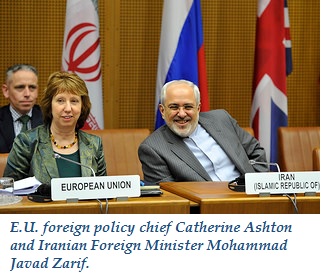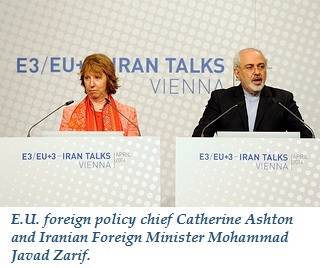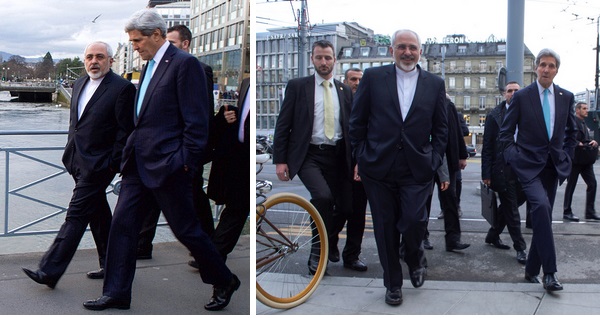The following is a rundown of key events in diplomacy on Iran’s nuclear program since President Hassan Rouhani took office in August 2013.
2013
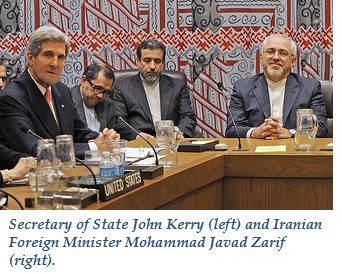 Sept. 26 –
Sept. 26 – Foreign ministers from P5+1 countries (Britain, China, France, Germany, Russia and the United States) and Iran met on the sidelines of the U.N. General Assembly and agreed to hold a new round of talks in Geneva.
Sept. 27 – President Barack Obama called Iranian President Hassan Rouhani in what was the first direct communication between a U.S. and Iranian presidents since the 1979 revolution. “The two of us discussed our ongoing efforts to reach an agreement over Iran’s nuclear program,” Obama said at a White House briefing.
Oct. 15-16 – Diplomats from P5+1 countries and Iran met in Geneva to solve the nuclear dispute. They committed to meeting in November to continue talks that were “substantive and forward looking.”
Nov. 7-10 – Iran and the P5+1 made significant headway but ultimately failed to finalize an agreement. Foreign ministers rushed to Geneva as a breakthrough appeared imminent. But last-minute differences, reportedly spurred by French demands for tougher terms, blocked a deal.
Nov. 11 – IAEA Director General Yukiya Amano visited Tehran. He and Iran’s chief of the Atomic Energy Organization, Ali Akbar Salehi, signed a Framework for Cooperation Agreement committing Tehran to take practical steps towards transparency within three months.
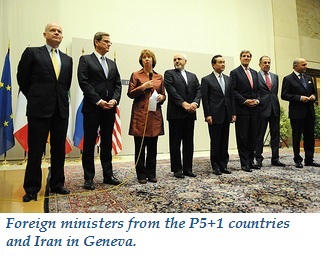 Nov. 24 –
Nov. 24 – Iran and the P5+1 reached an interim agreement that would significantly constrain Tehran’s nuclear program for six months in exchange for modest sanctions relief. Iran pledged to neutralize its stockpile of near-20 percent enriched uranium, halt enrichment above five percent and stop installing centrifuges. Tehran also committed to halt construction of the Arak heavy water reactor.
Dec. 11 – Iran and the IAEA met in Vienna to review the status of the six actions Iran committed to in November as part of the Framework for Cooperation Agreement.
2014
Jan. 20 – The Joint Plan of Action, the interim nuclear deal, entered into force. The International Atomic Energy Agency reported that Iran reduced stockpile of uranium enriched to 20 percent and halted construction on the heavy water reactor in Arak. The United States and the European Union announced steps to suspend a limited number of sanctions and allow the release of Iran’s oil revenues frozen in other countries.
March 19 –Iran and the six major powers held nuclear negotiations. Ashton and Zarif described their discussions as “substantive and useful.”
April 7-9 –Iran and the major powers met in Vienna for talks on a final nuclear agreement.
April 17 – The U.S. State Department announced steps to release $450 million installment of frozen Iranian funds, after the IAEA verified Tehran was complying with the interim nuclear agreement.
May 13-16 – Iran and the major powers met in Vienna, but the talks ended without tangible progress.
June 9-10 – U.S. Deputy Secretary of State William Burns lead a team of officials to Geneva for bilateral talks with Iran to prepare for the next round of P5+1 talks.
July 3-19 – Iran and the world’s six major powers began marathon talks on July 3, less than three weeks from the deadline. On July 19, the two sides announced an extension through November 24, the one-year anniversary of the interim agreement. Iran agreed to take further steps to decrease its 20 percent enriched uranium stockpile. The major powers agreed to repatriate $2.8 billion in frozen funds to Iran.
July 14 Update: Iran released the most detailed report to date explaining its practical needs for its nuclear program. It was posted on the quasi-official website NuclearEnergy.ir.
Sept. 18-26 – Iran and six major world powers resumed talks in New York. Kerry and Zarif also discussed the threat posed by ISIS.
Oct. 14-16 – Iran and the six major powers and made a “little progress” at talks in Vienna.
Nov. 9-11 – Kerry, Zarif, and Ashton met for two days of trilateral talks in Oman, followed by a day of meetings between Iran and all six major powers.
Nov. 19-24 – Iran and six major powers held talks in Vienna. On November 19, the U.S. and Iranian teams held bilateral talks. Kerry, Ashton, and Zarif held another round of discussions on Nov. 21. The two sides missed the November 24 deadline for a deal and announced that talks would be extended until June 30, with the goal of a political agreement by March.
Dec. 17 – Iran and the P5+1 held talks at the deputy level in Geneva. Deputy Foreign Minister Abbas Araghchi told reporters that the “intense negotiations” were “very useful and helpful.” No E.U. statement was released after the talks and the U.S. delegation did not provide comments to the press.
2015
Jan. 14, 16 – Kerry and Zarif met in Geneva to find ways to speed up negotiations. They meet again in Paris later in the week.
Jan. 15-17 – Iran and the U.S. hold bilateral talks in Geneva.
Jan. 18 – Iran and the P5+1 powers made limited progress in talks in Geneva. They agreed to meet again in early February.
Feb. 23 – Iran and the P5+1 concluded another round of talks on Iran's controversial nuclear program in Geneva. Atomic Energy Organization chief Ali Akbar Salehi and U.S. Energy Secretary Ernest Moniz joined the talks for the first time to provide technical expertise, but Secretary of State John Kerry noted that their presence was "no indication whatsoever that something is about to be decided."
March 2-5 – Iran and the P5+1 met in Montreux, Switzerland for another round of talks.
March 16-18 – Kerry and Zarif met in Lausanne, Switzerland, and Moniz and Salehi joined the talks to negotiate technical details. Zarif then flew to Brussels to meet with E.U. officials. The Iranian team returned to Switzerland for more talks with U.S. officials on March 17-18.
March 26-April 2 – Iran and the P5+1 met in Lausanne, Switzerland in the final days before the deadline for a political framework.
April 2 – Zarif and E.U. foreign policy chief Federica Mogherini issued a joint statement announcing that Iran and the P5+1 had reached an understanding on key parameters for a comprehensive nuclear deal, with the final agreement to be drafted by June 30.

April 22-24 – Iranian Deputy Foreign Minister Abbas Araghchi and E.U. political director Helga Schmid met in Vienna on April 22. Under Secretary of State Wendy Sherman and deputy foreign minister from the P5+1 joined them later in the week to begin drafting a final agreement.
April 27 – Kerry and Zarif
met on the sidelines of the 2015 Non-Proliferation of Nuclear Weapons Treaty Conference.
May 12-15 – Under Secretary of State Wendy Sherman and other deputy foreign ministers from Iran and the P5+1 met in Vienna to continue drafting a final nuclear deal.
May 27-30 – Deputy foreign ministers met in Vienna. Kerry and Zarif held talks in Geneva on May 30, their first
meeting since the April 2 announcement.
June 3-4 - Deputy foreign ministers from Iran and the P5+1
met in Vienna, following a day of expert-level meetings.
June 10-14 – Deputy foreign ministers from Iran and the P5+1 held
talks in Vienna.
June 17 – Deputy foreign ministers from Iran and the P5+1 held
talks in Vienna.
June 22-26 – Deputy foreign ministers from Iran and the P5+1 held talks in Vienna.
June 28-29 – Kerry held meetings with Zarif, Mogherini, and the British, German, and French foreign ministers in Vienna. Zarif traveled to Tehran on June 28.
June 30 – Negotiators announced talks would be extended until July 7. Zarif returned to Vienna, and Russian Foreign Minister Sergei Lavrov met with Kerry in Vienna.
July 1 – Kerry and Zarif met one-on-one, joined later by U.S., E.U., and Iranian negotiators at the deputy foreign minister level.
July 2 – Foreign ministers from Iran and the P5+1 held a series of bilateral meetings. Talks also continued at the deputy foreign minister level. International Atomic Energy Agency (IAEA) director Yukiya Amano visited Rouhani and other officials in Tehran.
July 3-6 – Talks were held at the foreign minister, deputy foreign minister, and expert level. Kerry and Zarif held several bilateral meetings.
July 7-9 – Negotiators announced talks would be extended to July 10. Meetings were held at the foreign minister, deputy foreign minister, and expert level.
July 10-13 – On July 10, negotiators announced talks would be extended to July 13. Talks continued at the foreign minister, deputy foreign minister, and expert level.
July 14 – Foreign ministers from Iran and the P5+1 announced they had reached a final nuclear agreement.
Photo Credits: EU External Action Service and U.S. State Department via Flickr
 Sept. 26 – Foreign ministers from P5+1 countries (Britain, China, France, Germany, Russia and the United States) and Iran met on the sidelines of the U.N. General Assembly and agreed to hold a new round of talks in Geneva.
Sept. 26 – Foreign ministers from P5+1 countries (Britain, China, France, Germany, Russia and the United States) and Iran met on the sidelines of the U.N. General Assembly and agreed to hold a new round of talks in Geneva. Nov. 24 – Iran and the P5+1 reached an interim agreement that would significantly constrain Tehran’s nuclear program for six months in exchange for modest sanctions relief. Iran pledged to neutralize its stockpile of near-20 percent enriched uranium, halt enrichment above five percent and stop installing centrifuges. Tehran also committed to halt construction of the Arak heavy water reactor.
Nov. 24 – Iran and the P5+1 reached an interim agreement that would significantly constrain Tehran’s nuclear program for six months in exchange for modest sanctions relief. Iran pledged to neutralize its stockpile of near-20 percent enriched uranium, halt enrichment above five percent and stop installing centrifuges. Tehran also committed to halt construction of the Arak heavy water reactor.